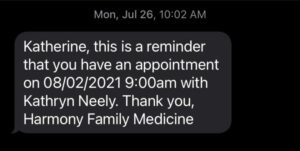There’s a simple reason that personalization is such a huge trend in healthcare marketing: it’s a win-win. On the one hand, consumers in the healthcare space and beyond want personalized experiences. They want to see tailored content. They want to be addressed by their first name. In its 2020 Trends in Personalization report, Salesforce found that 92 percent of marketers state that their customers and prospects expect a personalized experience (up from 85 percent last year).
On the other hand, enterprise marketing teams have an incentive to personalize their experiences, too. The latest research shows just how markedly personalization can improve marketing performance. The same Salesforce report, for example, found that 99 percent of marketers “overwhelmingly agree” that personalization is helpful in advancing customer relationships. This leaves only one question for healthcare marketers:
How can we personalize healthcare marketing content while still protecting patient privacy?
“The majority of marketers say that their prospects or customers expect a personalized experience. That’s up 7 percentage points compared to 2019.”
–2020 Trends in Personalization, Salesforce
Why Personalization is Worth Your Time and Effort
Every healthcare journey is relatively distinct. At least it feels that way to each person. Think about your last interaction with a doctor, dentist, or medical facility. If you’re like me, you were hardly seeing much beyond your own immediate healthcare needs.
Indeed, the last thing patients, healthcare consumers, and their loved ones want is to feel like just another number in a crowd—especially when making important healthcare decisions. Personalized marketing communications have the potential to change this perception—to enrich the patient experience, reduce friction, and even improve outcomes.
Here are just a few examples of how healthcare organizations use personalization today:
- Preventative healthcare material tailored to particular patient profiles
- Personalized reminders and preparatory information for upcoming appointments
- In-app or in-portal direct messaging with physicians
- Customized patient portals with updated test results, conditions, etc.
- Location-based website experiences (more on this later on)

3 Ideas for Personalizing Your Healthcare Experiences
Of course, personalization in the context of healthcare marketing is not without its obstacles. While creating high-value, highly personalized experiences is certainly a priority, almost nothing supersedes patient privacy. HIPAA restraints prohibit, for example, sending emails that contain, or are based on, personal health information (PHI).
“Personalization is impossible if marketers don’t have the means to understand the needs of high-value customers on an ongoing basis. So top marketers are developing systems that can pool and analyze structured and unstructured data, algorithms that can identify behavioral patterns and customer propensity, and analysis capabilities to feed that information into easy-to-use dashboards”
The future of personalization—and how to get ready for it, McKinsey & Company
It’s easy to see how sticky things can get when walking the line between marketing personalization and HIPAA compliance. Unfortunately, this leads many healthcare marketers to simply assume they can’t use personalization at all. This is far from the truth and a huge missed opportunity. To help set the record straight, here are a few ideas on how to personalize your healthcare experiences while working within the constraints of the latest healthcare privacy regulations.
1. Launch Personalized Patient Portals
Personally, one of my favorite developments in healthcare marketing has been the arrival of patient portals and mobile apps (Follow My Health is a strong example of the latter). Using a single login, I can see my appointment information, health records, and even communicate directly with my physicians. In some cases, I can see test results before my physician calls to discuss them with me.
It’s healthcare personalization at its finest.
Because patient portals are protected by login and password, they make it far easier to protect patient privacy. Patients have to register, acknowledge certain HIPAA agreements to make their accounts, and opt-in to certain communications, in order to establish their accounts. Of course, all sensitive information is kept private within the portal—only patients and their healthcare providers have access.
Within the patient portal, healthcare providers can personalize the experience far more freely than traditional marketing channels (email, form example). This is a great opportunity to provide patients with educational resources that help patients with their particular medical issues. Within the portal, they can also share relevant blog articles, videos, checklists, procedure follow-up instructions, and doctor notes.

2. Add a Little Personal Touch
It’s not all about email marketing campaigns and digital advertising. Adding a personal touch to other communications can go a long way. Addressing patients by name in digital communications, for example, such as email and text messaging, is a simple way to personalize the experience. The same goes for sending communications from the patient’s doctor. Some practices will personalize their communications based on location to build a little local camaraderie (location data is not necessarily protected by HIPAA regulations).
Others will use geographical personalization in a similar vein. For example, you can add geographical code to your website, which recognizes a visitor’s IP address to identify their location. The webpage can then be customized automatically to share the most relevant services and providers by location. This happens without the viewer realizing and creates a seamless digital experience that’s personalized to their location.
So instead of seeing providers or locations outside their region, they’re shown the doctors that are available nearby.

3. Give Consumers the Option to “Choose Your Own Adventure”
Then there’s the “choose your own adventure” approach to personalized healthcare marketing. Instead of using existing patient data to build campaigns, allow patients to determine what they see in a given experience. On your homepages and landing pages, for example, give patients the option to self-select who they are (“I’m a: new patient/existing patient”), or what they need (“I’m looking for: COVID-19 updates/make an appointment/contact my doctor”).
For example, an assisted senior living organization can give viewers the ability to immediately select “self,” “spouse,” “adult daughter,” and so on, so they only see web content relevant to their role in relation to the patient. From there, the information they receive is personalized to their persona and addresses their unique pain points and goals. This allows you to protect their privacy and still give them highly targeted information that will result in a more engaging session for the visitor. On the marketing side, this kind of personalization typically leads to far better engagement and conversion rates.
“Companies at the cutting edge of personalization innovation are more likely to—rightfully or not—trigger privacy concerns among the customer base. As such, proactively managing customer privacy will be especially important”
–“The future of personalization—and how to get ready for it”, McKinsey & Company
Bonus: Consider Investing in a HIPAA-compliant Email Marketing System
Look, a HIPAA violation hurts more than just your patients’ privacy—it can sting your wallet, too. Here’s what a HIPAA violation might cost according to TrueVault:
“The penalties for noncompliance are based on the level of negligence and can range from $100 to $50,000 per violation (or per record), with a maximum penalty of $1.5 million per year for violations of an identical provision. Violations can also carry criminal charges that can result in jail time.”
Even with the best intentions, it can be difficult to ensure that all email communications containing PHI are encrypted. Or that you’re ticking the other boxes like an unsubscribe option, or a sender address that’s monitored by real people.
One option is to invest in an email marketing platform that specializes in HIPAA compliance. Here are two examples:
Be Human and Bring Value
What you’ll find across the three healthcare personalization tactics we shared above is that they hinge on age-old marketing techniques, such as segmentation and audience personas. Location-based marketing is a great example: you can build a healthcare persona based on location, then target that persona with tailored communications, without violating HIPAA regulations.
There’s another common thread to the three tactics shared above, one that hearkens back to the point of personalization in the first place: bringing value to the patient journey. While personalization of any kind can certainly contribute to better marketing metrics—improved clicks, conversion rates, leads, and so on—it will ultimately fall short if it doesn’t create value.
In the end, personalization is an opportunity to educate, empathize, and reduce friction. Do that within the constraints of HIPAA and other regulations and you’ll be head and neck ahead of the competition.

